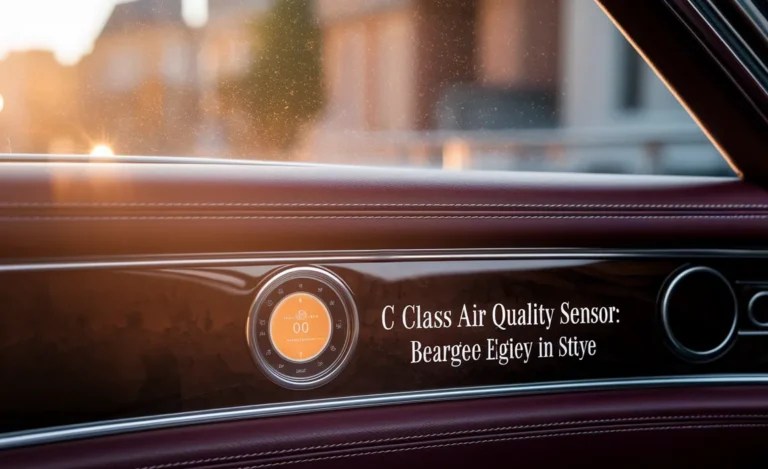C Class AC Issues: The Ultimate Solution
C Class AC issues can be frustrating, but often stem from simple causes like low refrigerant, a faulty cabin filter, or a malfunctioning blower motor. This guide provides a clear, step-by-step approach to diagnosing and fixing common Mercedes-Benz C-Class air conditioning problems, empowering you to enjoy cool comfort again.

The Mercedes-Benz C-Class is a masterpiece of engineering, offering a luxurious and comfortable driving experience. However, like any finely tuned machine, it can occasionally present a cooling challenge. When your C-Class AC blows warm air, makes strange noises, or fails to cool effectively, it can quickly turn a pleasant drive into an uncomfortable ordeal. Don’t worry, these C-Class AC issues are usually quite manageable, and with a bit of understanding and guidance, you can often resolve them yourself or know exactly what to tell your mechanic.
This comprehensive guide is designed to demystify common C-Class AC problems. We’ll break down the most frequent culprits, from the simplest fixes to more complex diagnoses, providing you with the knowledge and confidence to tackle these issues head-on. Get ready to reclaim that refreshing cabin climate.
Understanding Your C-Class AC System
Before we dive into troubleshooting, it’s helpful to have a basic grasp of how your C-Class air conditioning system works. At its core, it’s a closed-loop system that uses a refrigerant to absorb heat from your cabin and then release it outside. This remarkable process involves several key components:

- Compressor: The heart of the system, it pressurizes the refrigerant, making it hot and capable of releasing heat.
- Condenser: Located at the front of your car, this acts like a radiator, cooling the hot refrigerant and turning it into a liquid.
- Evaporator: Found behind your dashboard, this component absorbs heat from the cabin air as the liquid refrigerant turns back into a gas.
- Blower Motor: This fan pushes the cooled air through your vents and into the cabin.
- Refrigerant: The lifeblood of the system, a special chemical that circulates and changes state to absorb and release heat.
- Expansion Valve/Orifice Tube: Regulates the flow of refrigerant into the evaporator, controlling the cooling process.
When one of these components isn’t performing as it should, you’ll likely notice a change in your AC’s performance. Understanding these parts helps us pinpoint the source of your C-Class AC issues.
Common C-Class AC Issues and Their Solutions
Let’s get straight to the most common problems and how to address them. We’ll start with the easiest fixes and move towards more involved troubleshooting.

1. AC Blowing Warm Air
This is the most common complaint. If your C-Class AC is blowing warm air, several factors could be at play. It’s often a sign that the system isn’t able to adequately cool the air passing through it.
Possible Causes:
- Low Refrigerant Level: This is the number one reason for poor cooling. Refrigerant can leak out over time through tiny seals or connections.
- Faulty Condenser Fan: If the fan that cools the condenser isn’t working, the refrigerant won’t properly convert to a liquid, hindering the cooling process.
- Clogged Condenser: Debris like leaves, bugs, or dirt can block airflow through the condenser fins, preventing efficient heat dissipation.
- Compressor Issues: The compressor might not be engaging, or it could be failing internally.
Troubleshooting Steps:
- Check Refrigerant Level: This requires specialized equipment and knowledge. If you suspect low refrigerant, it’s best to have a professional check and recharge the system. Adding refrigerant without knowing the exact amount or identifying the leak can cause more harm. For basic DIY checks, you can sometimes find DIY recharge kits, but use them with extreme caution and follow instructions precisely.
- Inspect the Condenser Fan: With the engine off, visually check if the condenser fan (usually located in front of the radiator/condenser assembly) is free of obstructions. If it doesn’t spin when the AC is on (and the engine is running), it might need replacement.
- Clean the Condenser: Carefully spray the condenser fins with a garden hose from the back to push out debris. Avoid high pressure that could bend the delicate fins.
- Listen for the Compressor: When you turn on the AC, you should hear a distinct click as the compressor clutch engages. If you don’t hear this, or if the compressor makes loud, grinding noises, it might be the issue.
2. Weak Airflow from Vents
Even if your AC is producing cold air, poor airflow can make it feel like it’s not working effectively. This usually points to an obstruction or a problem with the air movement itself.
Possible Causes:
- Clogged Cabin Air Filter: This is the most frequent culprit. Your cabin filter traps dust, pollen, and debris, and when it’s saturated, it severely restricts airflow.
- Blocked Air Ducts: Though less common, something could be obstructing the flow within the dashboard.
- Failing Blower Motor: The blower motor is responsible for pushing air through the vents. If it’s weak or failing, you’ll get reduced airflow.
- Blend Door Actuator Malfunction: These actuators control flaps that direct air to different vents or mix hot and cold air.
Troubleshooting Steps:
-
- Replace the Cabin Air Filter: This is a very common DIY task for C-Class models. Consult your owner’s manual for the exact location (often behind the glove box or under the dash). Replacing this filter regularly dramatically improves airflow and air quality. A good quality replacement filter is essential.

- Check Fan Speed Settings: Ensure your fan speed is set to a higher setting to rule out a simple user error.
- Listen to the Blower Motor: Turn the fan speed up to its highest setting. If you hear unusual noises (whining, grinding) or if it only works on certain speeds, the blower motor might be failing.
- Check for Obstructions: While harder to access, ensure no objects are pushed into the vents.
3. AC Smells Musty or Like Mildew
A musty odor when you turn on the AC is a classic sign of mold or mildew growth within the evaporator core and air ducts. This is a common issue in humid climates or if the system hasn’t been run consistently.
Possible Causes:
- Moisture Buildup: Condensation naturally forms inside your AC system. If it doesn’t drain properly, it creates a breeding ground for mold and bacteria.
- Clogged Evaporator Drain: The AC system has a drain tube to remove condensation. If this is blocked, water backs up.
- Dirty Cabin Air Filter: An old filter can also contribute to musty smells by trapping moisture and organic matter.
Troubleshooting Steps:
- Replace Cabin Air Filter: As mentioned, an old filter can hold onto moisture and odors.
- Use AC System Cleaner: You can purchase specialized AC cleaning sprays designed to be introduced into the air intake or directly into the evaporator housing. These products kill mold and bacteria and neutralize odors. Follow the product’s instructions carefully. Some require running the AC in recirculation mode, while others are sprayed directly onto the evaporator coil.
- Ensure Proper Drainage: Locate the AC drain tube (often near the firewall on the passenger side of the vehicle’s exterior) and ensure it’s clear of debris. You might be able to gently poke it with a wire to clear it.
- Run the Fan After AC Use: A good practice to prevent future mold growth is to turn off the AC compressor a few minutes before you arrive at your destination but leave the fan running. This helps to dry out the evaporator core.
4. AC System Making Noise
Unusual noises are often an early warning that a component is struggling or has failed. The type of noise can help diagnose the issue.
Common Noises and Potential Causes:
- Grinding or Screeching: Could indicate a failing compressor bearing or the compressor itself.
- Hissing or Bubbling: Might suggest a refrigerant leak or air in the system.
- Clicking: Often the compressor clutch engaging or disengaging. If it’s constant or erratic, there may be an electrical issue or a problem with the clutch.
- Whining: Could be a failing blower motor or a pulley bearing.
Troubleshooting Steps:
- Listen Carefully: Try to pinpoint where the noise is coming from (under the hood, behind the dash).
- Check Belt Tension: For noises from the front of the engine, check the serpentine belt and its tensioner; a loose belt can cause squealing.
- Inspect Compressor Pulley: With the engine off, spin the compressor pulley by hand. If it feels rough or makes noise, the bearing might be shot.
- Have a Professional Diagnose: Noises related to the compressor or internal refrigerant issues are best left to a qualified technician. They have the tools to safely diagnose and repair these specific C-Class AC problems.
5. AC Leaking Water Inside the Cabin
A small amount of water dripping under your car is normal condensation. However, if you see water pooling inside the cabin, particularly on the passenger side floor, it indicates a more serious issue.
Possible Causes:
- Clogged Evaporator Drain Tube: The most common cause. Water backs up from the evaporator and leaks into the cabin, often through the air ducting.
- Damaged or Disconnected Drain Tube: The tube might have come loose or been damaged during other repairs.
- Blocked Air Ducts: In rare cases, debris might prevent water from reaching the drain.
Troubleshooting Steps:
-
- Locate and Clear the Drain Tube: This is the most crucial step. The AC drain tube typically exits the firewall on the passenger side of the vehicle. You may need to access it from underneath the car or by removing interior trim panels. Use a thin wire or compressed air to clear any blockages. Consult a Mercedes-Benz specific forum or technical guide for your C-Class model’s exact drain tube location.

- Inspect Drain Tube Condition: Ensure it’s firmly attached and not damaged.
- Dry the Interior: After clearing the blockage, thoroughly dry the carpet and the underlying foam to prevent mold and mildew. Use fans and dehumidifiers if necessary.
Essential Tools for DIY AC Maintenance
While many C-Class AC issues require professional intervention, a few basic tools can empower you for simpler tasks like cabin filter replacement or visual inspections.

- Screwdriver Set: For removing panels and covers.
- Socket Set: Useful for accessing components or securing panels.
- Trim Removal Tools: Plastic tools that help pry off interior trim pieces without causing damage.
- Gloves and Safety Glasses: To protect yourself.
- Flashlight: For inspecting hard-to-see areas.
- Can of AC Cleaner: For odor control.
- Replacement Cabin Air Filter: Essential for regular maintenance.
For refrigerant handling and more complex diagnostics, specialized tools like manifold gauges, leak detectors, and vacuum pumps are necessary, and these are best left to professionals.
When to Call a Professional
While DIY maintenance is rewarding, some C-Class AC issues are beyond the scope of a beginner’s toolkit or comfort level. It’s crucial to know your limits and when to enlist expert help:
- Suspected Refrigerant Leaks: Handling refrigerants improperly can be dangerous and environmentally damaging. Professionals have the equipment to detect leaks, recover old refrigerant, and safely recharge the system. You can learn more about refrigerant handling guidelines from organizations like the U.S. Environmental Protection Agency (EPA).
- Compressor Problems: If you suspect the compressor is faulty, only a trained technician can properly diagnose and replace it.
- Electrical System Issues: Problems with AC fuses, relays, or wiring require diagnostic tools and expertise.
- Complex Diagnoses: If you’ve tried the basic steps and the problem persists, a professional mechanic with Mercedes-Benz diagnostic equipment will be able to identify the underlying cause.
Trusting a qualified Mercedes-Benz specialist ensures your C-Class AC system is repaired correctly the first time, saving you potential further expense and frustration.
Preventative Maintenance for Your C-Class AC
The best “solution” to C-Class AC issues is often preventative maintenance. Keeping up with regular checks can prevent minor problems from turning into major repairs.
- Regular Cabin Air Filter Replacement: This is non-negotiable. Follow your Mercedes-Benz maintenance schedule, or replace it every 10,000-15,000 miles, especially if you drive in dusty conditions.
- Periodic System Check: Have your AC system inspected annually by a professional, especially before the hot summer months. They can check refrigerant levels, look for leaks, and ensure optimal performance.
- Run the AC Regularly: Even in cooler weather, run your AC for a few minutes each month. This circulates the refrigerant and lubricating oil, keeping seals from drying out and preventing leaks.
- Clean the Condenser: As mentioned, periodically ensure the condenser is free of debris to allow for maximum airflow and cooling efficiency.
- Listen for Changes: Pay attention to any new noises or changes in performance. Early detection is key.
Consistent care will ensure your C-Class AC remains a source of comfort and reliability.
Common C-Class AC Components & Their Lifespan Estimates
Understanding the general lifespan of AC components can help you anticipate potential future issues and budget for maintenance.
| Component | Estimated Lifespan | Notes |
|---|---|---|
| Cabin Air Filter | 10,000 – 15,000 miles / 1 year | Highly dependent on driving environment. |
| Condenser | 5 – 10 years | Can be damaged by road debris or corrosion. |
| Compressor | 8 – 15 years / 100,000 – 150,000 miles | Variable; depends on usage and maintenance. Often a major repair. |
| Blower Motor | 7 – 12 years / 80,000 – 120,000 miles | Can fail due to wear on bearings or electrical issues. |
| Evaporator Core | 8 – 15 years | Located deep within the dash; replacement is labor-intensive. |
| Refrigerant | System Lifetime (unless leaked) | Needs topping up only if there is a leak. |
These are general estimates, and actual lifespan can vary based on climate, usage, and the quality of maintenance performed. For instance, a C-Class driven in a very dusty or high-pollen area will require more frequent cabin filter changes.
FAQ: Your C-Class AC Questions Answered
Q1: How much does it typically cost to fix C-Class AC issues?
The cost varies greatly. Replacing a cabin air filter might be under $50 with a DIY approach, while a professional recharge could be $100-$250. Major repairs like a compressor replacement can range from $1,000 to $3,000 or more, depending on the specific C-Class model and labor rates.
Q2: Can I just refill the refrigerant myself?
While DIY recharge kits are available, it’s generally not recommended for Mercedes-Benz vehicles without understanding the system. Overcharging or undercharging can damage the system. It’s best to have a professional check for leaks and refill with the correct type and amount of refrigerant. Consult resources from organizations like the <a href=”https://www.mechromatic.com/






